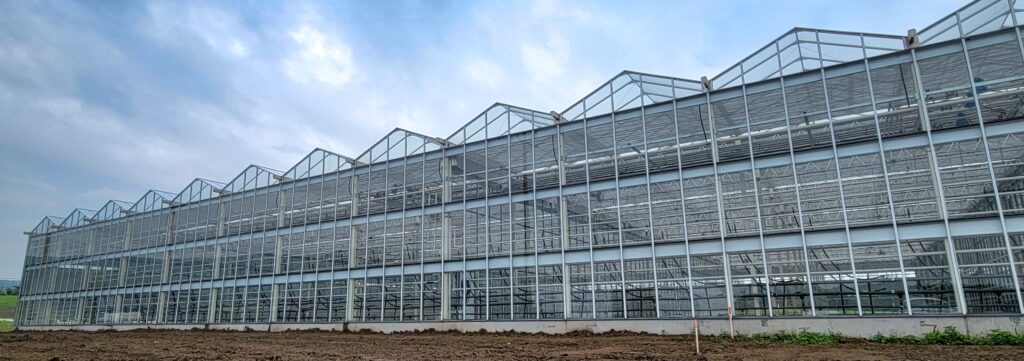Introduction
Greenhouses are essential structures for Controlled Environment Agriculture (CEA), enabling year-round cultivation and protection of crops from adverse weather conditions. Among the various types of greenhouses, polyethylene-covered greenhouses and glass houses are two prominent options. Each has its unique advantages and suitability for different applications.
Let’s explore the differences between them to understand their respective benefits.
A Comprehensive Comparison
Polyethylene (poly) greenhouse:
1. Cost-Effectiveness (ROI): Polyethylene-covered greenhouses are generally more affordable to construct compared to glass houses (for small and medium projects). The materials used, such as polyethylene film, are inexpensive, making them an attractive option for growers on a budget. The return on investment (ROI) is generally faster.
2. Lightweight Construction: Polyethylene-covered greenhouses are lighter in weight compared to glass houses. This characteristic makes them easier to assemble, transport, and modify according to changing needs.
3. Great Light Transmission: Modern polyethylene films used in greenhouses offer excellent light transmission properties, allowing adequate sunlight to reach the plants (90-91%). This promotes healthy growth and efficient photosynthesis.
4. Temperature Regulation (thermicity) : Polyethylene films are known for their insulating properties, helping to maintain optimal temperatures inside the greenhouse. They can retain heat during cooler periods and provide adequate ventilation during hot weather, creating a conducive environment for plant growth.
5. Great Insulation: Double-inflated polyethylene greenhouses can offer excellent insulation properties, often outperforming glass houses in terms of thermal efficiency. The air pockets created between the layers of polyethylene act as insulators, reducing heat loss and maintaining more stable temperatures within the greenhouse. This is particularly beneficial in regions with harsh climates, where maintaining optimal growing conditions is challenging. Additionally, the insulating properties of double-inflated polyethylene help to minimize energy consumption for heating, making them a cost-effective option for year-round cultivation.
6. Flexibility: Polyethylene films are flexible, allowing for easy installation on structures of various shapes and sizes. This flexibility enables growers to customize their greenhouse designs to suit specific crop requirements and available space.
7. UV Protection and management: High-quality polyethylene films (like 7,2mils) are designed to resist degradation from ultraviolet (UV) radiation, prolonging their lifespan and ensuring long-term performance in outdoor environments. It is also possible to use UV-Open poly for specific crops such as red lettuce, berries and cannabis to improve the agronomic performance.

Glass House:
1. Durability: Glass houses are known for their durability and longevity. Unlike polyethylene films, glass panels are resistant to tearing, puncturing, and degradation from exposure to environmental factors, offering a more permanent solution for greenhouse construction.
2. Increased Light Diffusion: Glass panels diffuse sunlight more evenly throughout the greenhouse compared to polyethylene films. This reduces the occurrence of hot spots and shadows, ensuring uniform light distribution for all plants, regardless of their location within the structure. Light penetration is also higher (95% and more), making it ideal for plants with greater photosynthetic activity.
3. Low Maintenance: Glass requires minimal maintenance compared to polyethylene films, which may need replacement periodically due to wear and tear. Routine cleaning is typically the only maintenance required for glass panels to maintain their clarity and performance.
4. Enhanced Security: Glass houses offer better security against pests, rodents, and unauthorized access compared to polyethylene-covered greenhouses. The solid structure of glass provides a more robust barrier, protecting valuable crops from external threats.
5. Sustainability: Glass is fully recyclable, whereas polyethylene is often difficult to recycle and can end up in landfills, contributing to environmental pollution. Using glass in greenhouse construction supports a closed-loop system where materials can be reused, reducing overall environmental impact.
6. Long-term Cost Savings: While the initial cost of constructing a glass greenhouse may be higher than that of a polyethylene greenhouse, the longer lifespan and lower maintenance requirements of glass can result in cost savings over time. Additionally, energy savings from improved insulation can further contribute to financial benefits in the long run.
7. Aesthetic Appeal: Glass houses have an aesthetic advantage, providing a visually pleasing environment for both growers and visitors. The transparent nature of glass allows for unobstructed views of the plants and creates an inviting atmosphere.


Vermax is the only North-American greenhouse manufacturer for large commercial project.
Conclusion
In conclusion, both polyethylene-covered greenhouses and glass houses offer unique advantages depending on the specific requirements and preferences of growers.
Polyethylene-covered greenhouses excel in terms of cost-effectiveness, flexibility and thermal insulation, while glass greenhouses stand out for their durability, light diffusion and lower maintenance.
Ultimately, the choice between the two depends on many factors such as budget, climate, desired lifespan, and aesthetic considerations. By understanding the differences between these options, growers can make informed decisions to optimize their greenhouse operations and maximize crop yields.


